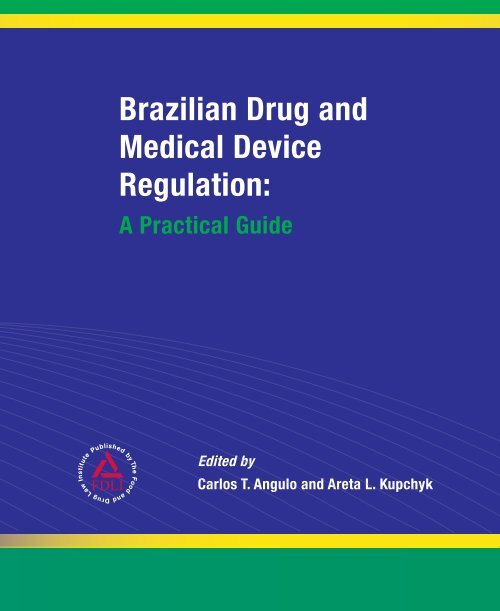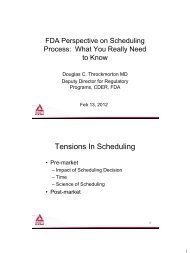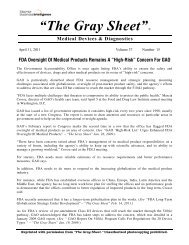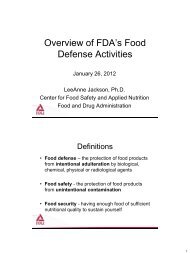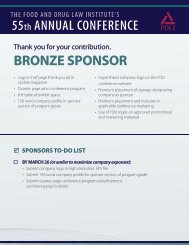Brazilian Drug and Medical Device Regulation - Food and Drug Law ...
Brazilian Drug and Medical Device Regulation - Food and Drug Law ...
Brazilian Drug and Medical Device Regulation - Food and Drug Law ...
Create successful ePaper yourself
Turn your PDF publications into a flip-book with our unique Google optimized e-Paper software.
<strong>Brazilian</strong> <strong>Drug</strong> <strong>and</strong><strong>Medical</strong> <strong>Device</strong><strong>Regulation</strong>:A Practical GuideEdited byCarlos T. Angulo <strong>and</strong> Areta L. Kupchyk
IntroductionThe <strong>Food</strong> <strong>and</strong> <strong>Drug</strong> <strong>Law</strong> Institute (FDLI) is pleased to provide <strong>Brazilian</strong> <strong>Drug</strong> <strong>and</strong> <strong>Medical</strong> <strong>Device</strong> <strong>Regulation</strong>: APractical Guide as a companion product to our pioneering conference, U.S. & Brazil: Navigating New Frontiers inPharmaceutical, <strong>Medical</strong> <strong>Device</strong>, <strong>and</strong> <strong>Food</strong> <strong>Law</strong> <strong>and</strong> <strong>Regulation</strong>. With this practical book <strong>and</strong> the groundbreaking2012 Brazil conference, FDLI is continuing its role as a leading provider of publications <strong>and</strong> programming in thearea of global food <strong>and</strong> drug law.Brazil is a fast-growing economy <strong>and</strong> of great interest to U.S. <strong>and</strong> international drug, medical device <strong>and</strong>food companies. Brazil is currently the eighth largest goods trading partner with $75 billion in total (twoway)goods trades during 2011. Exports were valued at $65 billion while imports were valued at $39 billion.U.S. goods <strong>and</strong> services trade with Brazil was estimated at $103 billion in 2011. In March 2011, Brazil <strong>and</strong>the U.S. signed an agreement on trade <strong>and</strong> economic cooperation <strong>and</strong> established the United States-BrazilCommission on Economic <strong>and</strong> Trade Relations, with the objective of promoting bilateral economic <strong>and</strong> tradecooperation, including intellectual property rights <strong>and</strong> regulatory issues affecting trade <strong>and</strong> investment.The U.S. <strong>Food</strong> <strong>and</strong> <strong>Drug</strong> Administration has opened offices outside of the United States <strong>and</strong> specifically in LatinAmerica, where it is collaborating with its counterpart, the <strong>Brazilian</strong> Health Surveillance Agency (ANVISA). U.S.drug <strong>and</strong> medical device companies wanting to do business in Brazil need to underst<strong>and</strong> ANVISA proceduresin administering the regulatory scheme for drugs <strong>and</strong> medical devices, as well as FDA requirements. ThisPractical Guide, written by experienced <strong>Brazilian</strong> lawyers <strong>and</strong> regulatory specialists, provides summaries ofBrazil’s requirements for the development, approval <strong>and</strong> marketing of drugs <strong>and</strong> medical devices. This Guidealso includes English translations of many relevant laws <strong>and</strong> directives. This Guide is intended to help you totake advantage of various marketing pathways <strong>and</strong> enable successful partnerships in Brazil.viii
Chapter 1. Overview of Regulatory Framework <strong>and</strong> Governmental Oversightin BrazilBy Marcelo França Brisolla, Angela Fan Chi Kung, Camila Martino Parise <strong>and</strong> Benny SpiewakLegal SystemBrazil is a Federative Republic in which broad powers are granted to the federal government. The Constitutioncurrently in force, promulgated on October 5, 1988, establishes a presidential system with three separatebranches: executive, legislative <strong>and</strong> judicial.The legislative arm of the government is the <strong>Brazilian</strong> Congress (the Senate <strong>and</strong> the House of Representatives),whose members are elected on a proportional representation basis weighted in favor of the less populatedstates.The judicial branch comprises the Federal Supreme Court, the Superior Court of Justice <strong>and</strong> various lowerfederal <strong>and</strong> state courts.Brazil is a civil law country, adopting a codified legal system with a hierarchy of laws that encompasses theConstitution <strong>and</strong> amendments to the Constitution, supplementary, ordinary <strong>and</strong> delegated laws, provisionalmeasures, decrees, <strong>and</strong> ordinances or resolutions.<strong>Law</strong>s, delegated laws, provisional measures <strong>and</strong> decrees are enacted by the <strong>Brazilian</strong> legislative branch.Ordinances <strong>and</strong> resolutions are enacted by the administrative authorities. Under the hierarchy of laws, anordinance or resolution cannot create rules or limitations not established in a law or a decree, as its purposeis restricted to supplementing <strong>and</strong> regulating them. However, regulation by administrative authorities oftenextends beyond the limits prescribed by law.The Constitution establishes the universal healthcare system, under which the state has the duty to provide allcitizens with access to healthcare, <strong>and</strong> creates the Unified System of Health (known as SUS).Brazil is the only country in the world with a population of more than 100 million inhabitants 1 that has auniversal healthcare system. This scenario gives rise to considerable pressure on the government to adoptpublic health policies aimed at guaranteeing access to health at the lowest cost possible. As a result, thegovernment, as the main payer for drugs <strong>and</strong> healthcare services, often intervenes in the market by controllingprices <strong>and</strong> imposing m<strong>and</strong>atory discounts.Supervision <strong>and</strong> Administration<strong>Drug</strong>sThe <strong>Brazilian</strong> Federal Constitution has entrusted the provision of public healthcare to the Ministry of Health(MOH).In 1999, the National Agency of Sanitary Surveillance (ANVISA) was created 2 as an independent agencyoperating under a special regime <strong>and</strong> reporting to MOH. ANVISA was given the duties of sanitary surveillance,including powers to regulate <strong>and</strong> supervise the registration, manufacture, distribution <strong>and</strong> dispensing of drugs<strong>and</strong>, thus, to ensure the health <strong>and</strong> safety of consumers. ANVISA is ruled by a Collegiate Board of Directorscomposed of five members.
BRAZILIAN DRUG AND MEDICAL DEVICE REGULATION: A PRACTICAL GUIDEThe “health authority” concept encompasses a number of governmental authorities devoted to theprotection of health, from ANVISA down to its several departments <strong>and</strong> including State <strong>and</strong> Municipal HealthDepartments. Supervision of product quality <strong>and</strong> safety, as well as of means of production, is simultaneouslyentrusted to the three government levels (federal, state <strong>and</strong> municipal). <strong>Regulation</strong>s, in turn, apply to the entirecountry when issued by ANVISA. Although the same authority is granted to other government levels, thescope of these regulations is obviously limited to their respective jurisdictions. The pharmaceutical industry isregulated by MOH <strong>and</strong> ANVISA at their various departments <strong>and</strong> levels.Each state is competent to establish the requirements that it deems necessary for effective sanitarycompliance, subject to federal legislation.Product registration, clearance of drugs at the ports <strong>and</strong> airports, certification of Good Manufacturing Practices(GMP) <strong>and</strong> compliance with advertising rules on drugs are dealt with at the federal level by ANVISA.Surveillance <strong>and</strong> inspection of pharmaceutical companies are dealt with at the state or municipal levels.<strong>Medical</strong> <strong>Device</strong>sANVISA is responsible for the supervision <strong>and</strong> administration of medical products, including medical devices.ANVISA governs the import, distribution <strong>and</strong> marketing of medical devices. Product registration, premarketsubmission <strong>and</strong> approval are required. 3 A foreign company must work through a local <strong>Brazilian</strong> entity to obtain amarketing license from ANVISA to import <strong>and</strong> distribute medical devices in Brazil.There are two regulatory pathways for medical devices: 1) notification (“cadastro”) for Class I <strong>and</strong> II devices thatare considered low risk <strong>and</strong>, therefore, subject to basic controls; <strong>and</strong> 2) registration (“registro”) for Class III <strong>and</strong> IVdevices, which are considered higher risk, <strong>and</strong> Class I <strong>and</strong> II devices that are deemed higher risk <strong>and</strong>, therefore,are subject to greater controls. 4Available Sources of <strong>Law</strong>s <strong>and</strong> <strong>Regulation</strong>s: A Quick Reference<strong>Drug</strong>sThe <strong>Brazilian</strong> Presidency <strong>and</strong> Senate websites (www.planalto.gov.br <strong>and</strong> www.senado.gov.br, respectively)contain an updated version of the Constitution <strong>and</strong> its amendments, supplementary, ordinary <strong>and</strong> delegatedlaws, provisional measures <strong>and</strong> decrees.Sanitary ordinances <strong>and</strong> regulations can be found at ANVISA’s website (www.anvisa.com.br) <strong>and</strong> the Ministry ofHealth’s website (www.saude.gov.br). However, such websites do not always provide current versions of suchlegal documents.Therefore, the most reliable sources for updated sanitary regulations are law firms or other private sources ofinformation, although these private entities charge their users a certain access fee <strong>and</strong> their databases are all inPortuguese.<strong>Medical</strong> <strong>Device</strong>sThe following are regulations relevant to medical devices:(1) ANVISA Resolution RDC No. 3 of 2 February 2010 – How registration submissions are prioritized2
OVERVIEW OF REGULATORY FRAMEWORK AND GOVERNMENTAL OVERSIGHT IN BRAZIL(2) ANVISA Resolution RDC No. 16 of 23 April 2009 – GMP certification <strong>and</strong> maintenance(3) ANVISA Resolution RDC No. 24 of 21 May 2009 – Registration application process(4) ANVISA Resolution RDC No. 25 of 21 May 2009 – Establishes onsite GMP inspection requirementbased on device risk(5) ANVISA Resolution RDC No. 27 of 21 June 2011 – INMETRO certification procedures(6) ANVISA Resolution RDC No. 39 of 5 June 2008 – <strong>Regulation</strong>s pertaining to clinical research(7) ANVISA Resolution RDC No. 55 of 4 November 2011 – Requirements for surgical <strong>and</strong> examinationgloves(8) ANVISA Resolution RDC No. 59 of 27 June 2000 – Good Manufacturing Practices for medical devices(9) ANVISA Resolution RDC No. 67 of 21 December 2009 – Vigilance requirements(10) ANVISA Resolution RDC No. 81 of 5 November 2008 – Technical regulations for imported goods(11) ANVISA Resolution RDC No. 97 of 9 November 2000 – Product family definition(12) ANVISA Resolution RDC No. 167 of 2 July 2004 – Guidelines for inspection of IVD manufacturers(13) ANVISA Resolution RDC No. 185 of 13 October 2006 – Economic Information Report requirements(14) ANVISA Resolution RDC No. 185 of 22 October 2001 – <strong>Medical</strong> device classification rules, technicalfile requirements(15) ANVISA Resolution RDC No. 61 of 18 November 2011 – IVD classification <strong>and</strong> requirements(16) ANVISA Resolution RDC No. 3385 of 13 October 2006 – List of products which require an EconomicInformation Report(17) Ordinance 686 of 27 August 1998 – Brazil Good Manufacturing Practices for in vitro diagnosticsEndnotes1. http://portalsaude.saude.gov.br.2. <strong>Law</strong> No. 9782/99.3. <strong>Law</strong> No. 6360 of 1976, Decree 74.094/97, ANVISA Resolution RDC No. 85/2001.4. ANVISA Normative Ruling No. 2/2011.3


